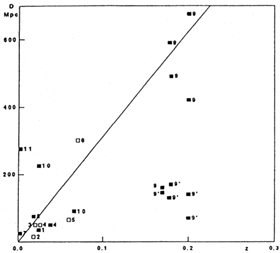


2.1.3 Structures discovered in redshift space
Histograms of z-distributions show peaks suggesting the presence of clusters and empty regions suggesting the presence of voids. In fact, the recognition of voids was possible on the basis of accumulating redshift data. Chincarini (1978) referred to communications since the early 1970s when he wrote:
``Observations of redshifts on samples complete to a given limiting magnitude have shown that redshifts exist in which for a given region of the sky no galaxies are observed.''
A most striking example of a void was presented by Kirshner et al. (1981), the Bootes void. The same paper gives references from 1978 onward. A recent review paper by Rood (1988) gives history, present knowledge and future routes concerning voids.
Remarkable structures so-called bubbles, were found from data of the second CfA (de Lapparent et al. 1986). In three-dimensional real space these structures are difficult to interpret because of the superposition of two kinds of redshifts: those due to individual motions of the galaxies and those due to their participation in the Hubble flow which is used to position them in real space.
Theory provides explanation for both, the presence of bubbles in real space (explosive events during the early history of the universe; Ostriker and Cowie 1981) and the absence of bubbles in real space (artifacts in velocity space; Kaiser 1987).

|
Figure 13. Increase of observed structure sizes with increasing depth of surveys. Open symbols: voids; filled symbols: clusters and superclusters of galaxies. References indicated by numbers are found in Seitter (1986). |
The tendency of structures to `grow' with increasing depths of surveys is illustrated in Fig. 13 (Seitter 1986).